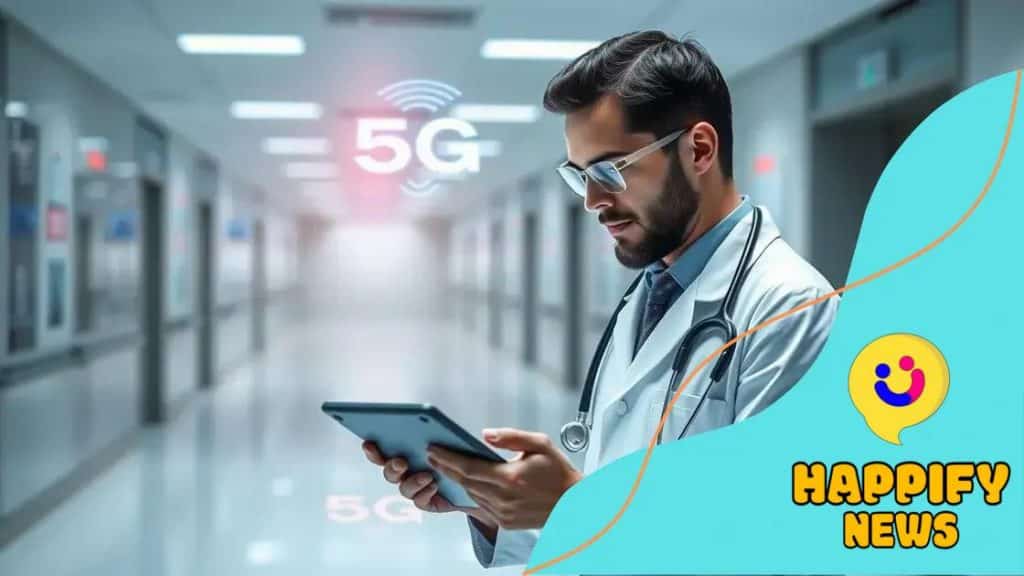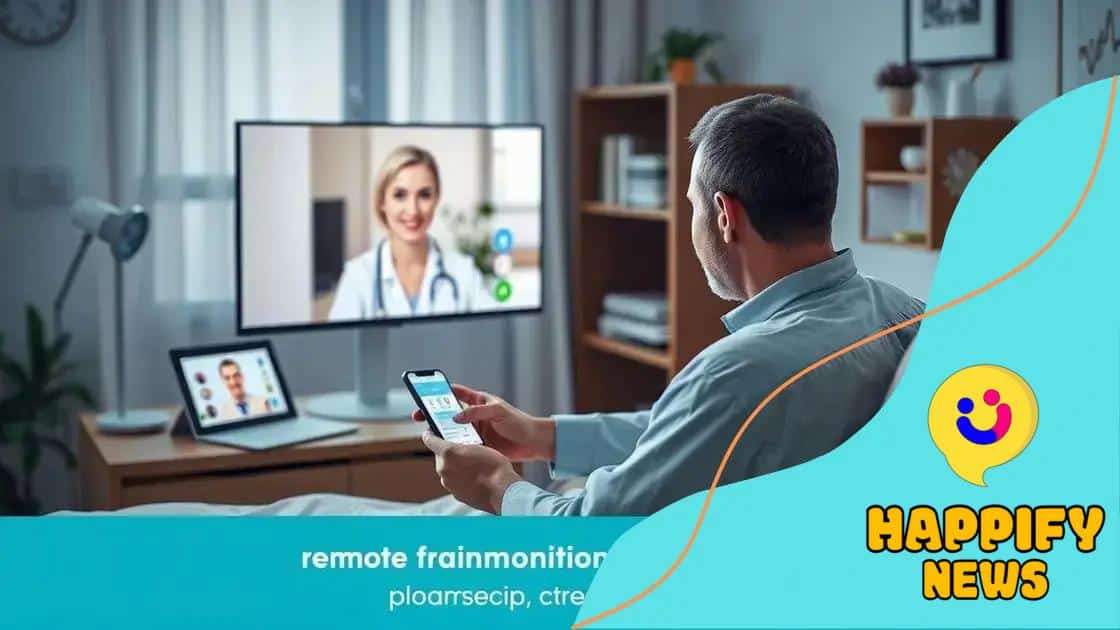5G revolutionizing healthcare delivery: a game changer

Anúncios
5G is revolutionizing healthcare delivery by offering faster data transmission, improving telehealth services, enabling real-time data analytics, and expanding access to care in underserved areas.
5G revolutionizing healthcare delivery is more than just a buzzword; it hints at a transformative wave sweeping through medical practices. Have you considered how connectivity shapes patient experiences?
Anúncios
Understanding the basics of 5G in healthcare
Understanding the basics of 5G in healthcare is crucial as this technology is set to change the medical field dramatically. With faster data speeds and better connectivity, healthcare providers can deliver enhanced services to patients.
What is 5G?
5G is the fifth generation of mobile network technology. Unlike its predecessors, it offers significantly higher speeds, lower latency, and the ability to connect more devices simultaneously. This is especially important in a healthcare setting where many devices need to communicate seamlessly.
Key Features of 5G in Healthcare
Some of the standout features of 5G technology that benefit healthcare include:
Anúncios
- Higher bandwidth for video consultations
- More reliable connections for remote monitoring
- Faster data exchange for medical imaging
- Enhanced capacity for smart medical devices
These advancements allow healthcare providers to offer services like telemedicine, where patients can consult doctors remotely. This was particularly useful during the pandemic when people needed to stay at home.
The impact of 5G extends beyond just speed. It enables real-time data transfer, which is vital for operations like robotic surgeries or emergency medical responses. As healthcare systems integrate more devices, having a robust network becomes essential for managing patient data effectively.
How 5G Works
5G works by using higher frequency radio waves, which can transmit data much faster than previous generations. These waves can also support more devices at once, making it perfect for busy healthcare environments. For instance, imagine a hospital where thousands of sensors are constantly sending data about patient conditions. This level of connection wasn’t feasible before 5G.
Patients will feel more at ease knowing their care is backed by the best technology. The reliability of 5G ensures important data is always transmitted quickly and accurately, making modern healthcare safer and more effective.
Benefits of 5G for patient care
The benefits of 5G for patient care are becoming clearer as technology evolves. With this new technology, healthcare is evolving to meet the needs of patients better and faster.
Faster Communication
One of the most important benefits of 5G is that it enables faster communication between patients and healthcare providers. With reduced latency, telehealth services can provide nearly real-time consultations. Imagine speaking with a doctor through a video call without delays, making it easier to understand health concerns.
Remote Monitoring
5G also enhances remote monitoring of patients. Wearable devices that track vital signs can transmit data instantly to healthcare professionals. This allows doctors to monitor patients’ health from afar and respond quickly if an issue arises.
- Continuous tracking of health metrics.
- Immediate alerts for critical changes.
- Better management of chronic conditions.
Such capabilities mean that patients with chronic illnesses can receive proactive care. Instead of waiting for regular check-ups, their physicians can stay informed and act swiftly when necessary.
Enhanced Data Transmission
Another major advantage of 5G is the ability to transfer large amounts of data quickly. This is particularly critical for imaging and diagnostics. High-quality images can be sent to specialists in mere seconds, allowing for faster and more accurate diagnoses.
The result is improved patient outcomes and quicker treatment plans. With healthcare professionals having all necessary data at their fingertips, they can make informed decisions without unnecessary delays.
Innovative Medical Technologies
The integration of 5G facilitates innovative medical technologies. Examples include augmented reality (AR) and virtual reality (VR) applications used for training or even consulting during surgeries. These technologies require high-speed connectivity to function effectively.
As more healthcare providers adopt 5G, the possibilities for improving patient care will continue to grow. This creates a future where healthcare becomes more accessible and effective for everyone, ensuring patients receive the best care possible.
Remote monitoring and telemedicine advancements

Remote monitoring and telemedicine advancements have become essential in the healthcare landscape. With the rise of 5G, these technologies are transforming how patients receive care from the comfort of their homes.
The Impact of Remote Monitoring
Remote monitoring allows healthcare professionals to keep track of patients’ health metrics without the need for in-person visits. Devices like heart rate monitors and glucose meters can send data directly to doctors in real-time. This means patients can stay connected and receive guidance even when they’re miles away from their healthcare providers.
Benefits of Telemedicine
Telemedicine expands access to care, especially for patients in rural areas. It enables individuals to consult with specialists without traveling long distances.
- Increased convenience for patients.
- Reduced healthcare costs.
- Shorter waits for appointments.
- Continuous patient engagement and follow-up.
Moreover, telemedicine session lengths have decreased, allowing more patients to be served in a day. By using video calls and messaging platforms, healthcare providers can address a variety of conditions effectively.
Enhanced Patient Outcomes
The advancements in remote monitoring and telemedicine lead to better patient outcomes. Since doctors can monitor health data continuously, they can respond quicker to changes and make informed decisions. For instance, if a patient’s heart rate spikes, the doctor can intervene immediately, reducing risks significantly.
Additionally, these technologies promote adherence to treatment plans. With regular check-ins through telehealth, patients feel more supported and accountable for their health, leading to improved results over time.
Technology Integration
As technology evolves, so does the integration of remote monitoring tools with electronic health records (EHRs). This means that all patient data is centralized, allowing for seamless communication between multiple care teams. Medical professionals can access a patient’s entire health history during a remote consultation, enhancing the quality of care.
With advancements in 5G, the future looks even more promising for remote monitoring and telemedicine, enabling features like instant data streaming and better interaction between healthcare providers and patients.
Challenges in implementing 5G technology
Implementing 5G technology in healthcare presents several challenges that need to be addressed. While the benefits are clear, overcoming obstacles is essential for successful adoption.
Infrastructure Requirements
One significant challenge in implementing 5G is the need for a robust infrastructure. Existing healthcare facilities may need upgrades to support new technologies. For example, 5G networks require more base stations to provide coverage, especially in large and complex hospital environments.
Cost of Implementation
The initial costs of transitioning to 5G can be high. Expenses include upgrading hardware, training staff, and maintaining new systems. Without adequate funding, smaller healthcare providers may struggle to adopt this technology.
- Investments in new equipment.
- Training for staff to effectively use new tools.
- Potential ongoing costs for network maintenance.
These financial aspects can deter some healthcare organizations from making the switch. It requires careful planning and budgeting to ensure resources are available.
Data Security Concerns
Another challenge is ensuring data security. With more devices connected through 5G, there is a greater risk of data breaches and cyberattacks. Healthcare data is particularly sensitive, and any compromise can have serious consequences.
To mitigate these risks, organizations must implement strong cybersecurity measures. This includes encryption, secure access protocols, and ongoing monitoring of networks to detect suspicious activities.
Regulatory Hurdles
Healthcare is a highly regulated industry. Adapting to new 5G technology must comply with existing regulations. Organizations need to ensure that all solutions meet legal requirements, which can be time-consuming and complex.
Additionally, healthcare providers must be familiar with evolving regulations related to telemedicine and data privacy to avoid penalties.
Despite these challenges, the push for 5G in healthcare is strong. By addressing infrastructure needs, costs, security, and regulation, the industry can move closer to realizing the full benefits of this transformative technology.
Future prospects of 5G in health services
The future prospects of 5G in health services are exciting and full of potential. As this technology evolves, it promises to reshape how healthcare is delivered, making services faster and more effective.
Advanced Telehealth Solutions
With the capabilities of 5G, telehealth solutions will become more advanced. Patients will have access to high-definition video calls with their doctors, making remote consultations feel more personal and effective. This means patients can get the care they need without leaving their homes.
AI and Data Analytics
The combination of 5G technology and artificial intelligence (AI) will revolutionize patient care. More real-time data can be processed, allowing for faster decision-making. AI algorithms can analyze health data and provide insights to doctors almost instantly.
- Improved diagnostic accuracy.
- Proactive health management.
- Tailored treatment plans based on data.
This integration can lead to a more patient-centric approach, where treatments are customized to fit individual needs and conditions, improving overall health outcomes.
Expanded Reach of Services
5G can also expand healthcare services to underserved areas. By offering reliable high-speed internet, healthcare providers can reach patients in remote communities. This connectivity can help bridge gaps in care, ensuring everyone has access to essential health services.
Mobile health clinics equipped with 5G technology can provide diagnostic services and health education, bringing healthcare directly to those who need it most.
Enhanced Medical Research and Collaboration
The future of 5G in health services also includes enhanced medical research and collaboration. Researchers can share large data sets faster, facilitating collaborative studies that lead to new treatments and innovations.
Remote surgeries could become a reality, where specialists from different locations can work together on complex procedures in real time, guided by expert opinions and advanced imaging technologies.
The potential of 5G in healthcare is vast. By continuing to invest in this technology, we can build a more connected, efficient, and effective healthcare system for the future.
FAQ – Frequently Asked Questions about 5G in Healthcare
How will 5G technology improve telehealth services?
5G technology enables high-definition video calls and faster data transmission, making remote consultations more effective and personal.
What are the benefits of real-time data analytics in healthcare?
Real-time data analytics allows for faster decision-making, improved diagnostic accuracy, and personalized treatment plans based on ongoing health monitoring.
What challenges does 5G face when implemented in healthcare facilities?
Challenges include the need for upgraded infrastructure, high implementation costs, data security concerns, and compliance with healthcare regulations.
How can 5G expand access to healthcare services?
By providing reliable high-speed internet, 5G can reach underserved areas, allowing telehealth services and mobile clinics to deliver care directly to patients.






